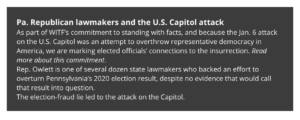WITF.org is the public broadcaster in the Harrisburg region of central Pennsylvania. On January 28 the newsroom explained a new policy toward those in public office who spread the election fraud lie and encouraged the January 6 insurrection. The journalists at WITF declared that they intended to contextualize future actions by these officals with reminders about their fateful moves in the period between the 2020 election and the inauguration of Joe Biden.
I wrote about the bold actions of WITF in a post that described similar efforts by other newsrooms. See: If you’re worried that journalists have learned nothing from the Trump years. But I couldn’t include in that post everything of note in WITF’s decision-making, so I asked the authors of the January 28 piece a series of questions about the logic of their decision, and what has happened since. Here are their answers. Tim Lambert is the news director and “Morning Edition” host at WITF. Scott Blanchard is an editor in the WITF newsroom. They work closely together.
What we did:
Scott: We created language to use in stories on air and online that would make note of Pa. elected officials who took one of four actions: Signed on to the Texas lawsuit seeking to invalidate Pa.’s presidential vote; signed a letter to Pa. congressional reps asking them to vote against certifying Pa.’s electoral votes; signed a letter asking those reps to delay certifying the state’s electoral votes; and/or voted against certifying the electoral votes on Jan. 6 (actually early morning Jan. 7).
Tim: This builds off our approach ahead of the election reminding our listeners/readers that the vote totals on election night will not be the final results. We tried to be proactive ahead of the election. We simply did not expect the disinformation/misinformation about fraud to spread as widely as it did.
Scott: We did it because we wanted to connect the dots between Trump’s election-fraud lie that began during the summer, actions in support of that lie, and the Jan. 6 attack on the U.S. Capitol. The lie and its connection to the Jan. 6 attack on the Capitol has been documented by national reporting, by evidence presented during the impeachment trial, and by multiple public statements from public officials of both political parties (most recently by ex-DOD head Chris Miller); and that information is being corroborated by allegations contained in charging documents against some of the Capitol attackers.
Tim: What was being said by the president, his supporters and his media backers did not square with what our own journalists (who live in these communities) were seeing on the ground in terms of alleged fraud. It just wasn’t there. We read the lawsuits and the language didn’t square with our reporting.
Scott: We wanted to do what we could to amplify the connection, hoping knowledge can sap the power of that lie — still believed, even now, by so many. We also believe it’s important to publicly underscore how different this was from standard political spin or messaging or debate. We saw an attempt to keep a defeated president in power by physical violence. The roots of that effort grew from the “rigged election” claim, which was cultivated for months. This was not the same thing as a policy debate over immigration, for example.
Tim: There is no comparison in recent political history on such a massive disinformation campaign and how it was embraced not only by the base of his supporters, but by elected and appointed leaders at all levels of government – who used social media platforms to reinforce the lie on a daily, if not hourly basis.
Scott: As part of the transparency plank of this effort (see below re: Trusting News), we tried to lay all that out in the two stories that posted Jan. 28.
Reactions, threats, other developments:
Scott: The public reaction has been overwhelmingly positive on social media in particular. People have thanked us for standing up for the facts, and some have said they wish other news orgs would do something like this too. People have said they’re proud of us. That’s heartening.
Tim: Some said they made an extra donation as a result. We have received national mentions as well.
Scott: We’ve had a few negative responses. The biggest is that we are showing our bias, by choosing sides. Most cite Fox News talking points and continually moved the goal posts: Nancy Pelosi’s haircut, for example, or the “Russia hoax,” or, ‘”Why didn’t you do this when Democrats objected to Trump’s certification?” (The latter was anticipated & answered here.) Some have criticized us as much for saying we were doing it as for doing it. But we’ve been involved with the Trusting News effort for several years, and transparency is a big part of that. It would have been unnatural for us to just start dropping this language into stories without explaining to people what we were doing and why, and inviting them to talk to us about it.
Tim: Some say they will never donate to WITF (We checked… they never have).
Scott: One man, a two-time Trump voter who described himself as “not a kraken believer or a Trump worshiper,” wrote that by taking a stand like this, we were “maintaining the same narrative that we heard before and after the election. It needs to change or you will never reach us.” Tim and I set up a call and talked with him for 45 minutes to an hour. We mostly listened. And we talked about the facts that led us to make the decision we made.
We hope and plan to continue that type of effort. For example, we’ll be participating in a Trusting News effort to find out more about what political conservatives think about local news (as opposed to ‘the media.’) We’re also connected with America Talks.
Tim: We haven’t experienced any threats – except some people said they’d fight to cut off our national/state/individual funding.
Scott: The most significant developments are probably a couple things about the actual use of the language:
* We initially envisioned working the language into the bodies of stories, even stories that did not have anything to do with the election, election law, etc. For example, “State Sen. XX, who signed a letter asking members of Congress to delay certifying Pennsylvania’s electoral votes despite no evidence that would call those results into question, questioned the health department’s request for a budget increase.” But shortly after we debuted the language, as we discussed it with reporters, we realized that wasn’t the best way to present it. So, for air, we moved the language out of the story and into a host tag, read after the story ends; for digital, we developed text boxes that now run with each story in which a lawmaker is mentioned. (Example of what it looks like.)
* We used the language in one story about a proposed sex abuse survivors’ rights amendment. One of the lawmakers quoted was a victim of sexual abuse; he was also one of the politicians who contributed to the election-fraud lie. We used the language. He objected, saying that it was triggering for him to see that language in a story related to trauma he had survived. We strive to be a trauma-aware newsroom, so we decided to take out the language and explain we wouldn’t use it in this very specific circumstance. Sam Dunklau, our state Capitol reporter, connected with the lawmaker later about this.
* That lawmaker is the only one who has responded to our use of the language, that we are aware of. But Sam did pursue a story about GOP legislators’ post-election actions, and talked to two for this story. You can see how we modified the language based on the two different responses from the lawmakers.
What internal discussions preceded the Jan. 28 post?
* Tim and I discussed this frequently with each other and with our boss, Cara Williams Fry, WITF’s senior VP & chief content officer, as well as a small group of managers who meet regularly to discuss and challenge protocols — the way we’ve always done things. We vetted the draft of our work with Trusting News’ Lynn Walsh, who was very insightful and helpful in what we produced and how we rolled it out, and with NPR’s public editor Kelly McBride. Tim bounced it off some of his colleagues from other media organizations as well. We had a meeting with news staff and Lynn; we had distributed the draft before the meeting and asked people to come with questions, thoughts, etc. The staff was supportive, appreciative and welcoming of the effort, and helped us fine-tune what you saw online in January. It’s important to note that this didn’t come out of the blue here. We have regular discussions around fact-checking and truth-telling, and this effort evolved out of that culture.
* One of the key things in those discussions was something Tim and I thought of & talked about a lot: By doing this, can we no longer say we’re independent journalists — a point of pride for everyone at WITF? Are we taking a political side? I’ve been active in ethics and credibility issues during my career, and this is certainly unlike anything I’ve ever been involved in. But we kept coming back to connecting the dots and to the ultimate result of the election-fraud lie: An attack on the legitimacy of U.S. elections and the government itself. There is nothing comparable. Political party is irrelevant. The actions and facts are what mattered. This was a concerted effort to convince a significant portion of America that the election was stolen. We believe we’re doing the right thing.
Editor’s note: here’s an example of a text box WITF used online to explain to readers and listeners why they are contining to connect local office-holders to their actions during the insurrection. The original is here. 
